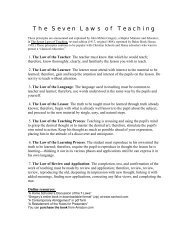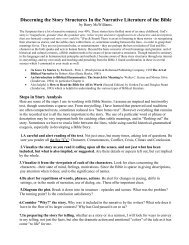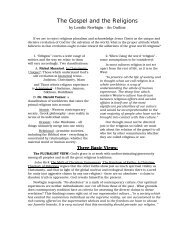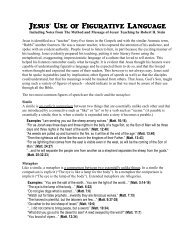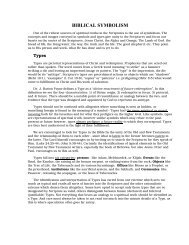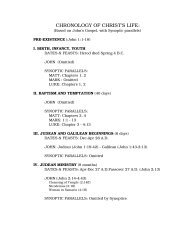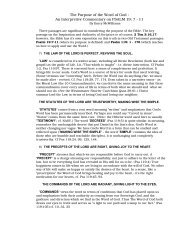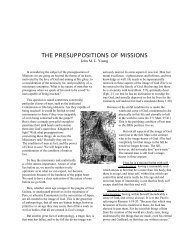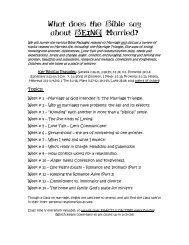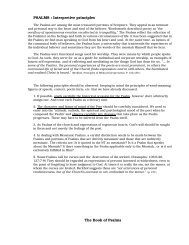Carcassonne
Carcassonne
Carcassonne
Create successful ePaper yourself
Turn your PDF publications into a flip-book with our unique Google optimized e-Paper software.
The Count of <strong>Carcassonne</strong>: The default starting tile is not used. Before the game, the 12 expansion<br />
tiles (which are numbered 1-12) are placed such that they form the large city of <strong>Carcassonne</strong> in a 4x3 grid.<br />
The Count figure is placed in the Castle quadrant of the city. The city acts as the starting point for the<br />
game; all drawn tiles are placed adjacent to the tiles representing the city. This variation may be played<br />
with other start-of-game expansions (such as The River), but The Count of <strong>Carcassonne</strong> is always placed<br />
first. In the case of The River, the city of <strong>Carcassonne</strong> is assembled first, with the river tiles placed such<br />
they flow away from the city.<br />
Some Alternate River beginnings:<br />
* Various Springs pieces (2) One played first. [Another, when drawn, could start a second river.] (variant)<br />
Road at springs (No Farm wraparound)<br />
* Start river at Count of <strong>Carcassonne</strong> base –<br />
* Or place a regular piece in the river pile, when drawn the player plays it alongside the river and using it<br />
places the Count of <strong>Carcassonne</strong> city one tile away from the river at some point along its length– possibly<br />
rolling dice for number of river tiles back to link it through.<br />
Alternate River endings * Lake ending (River 1)<br />
* Shuffle in one Lake, when drawn ends that river, the next player uses a spring to start a second river. *<br />
Use the Lake and Volcano end piece if playing the Princess and Dragon expansion to put the dragon<br />
immediately in play. (River 2) * Ends in a lake with a city on one side (piece in River II) * Estuary – one<br />
side into salt water – a “one tile wide opening” to the sea must be maintained out from it.<br />
The Princess and the Dragon The Dragon is placed on the first volcano played – usually at the end of<br />
the river. As soon as a tile with a dragon is uncovered, the player places this tile and may place a meeple<br />
on it as normal. Then the play is briefly interrupted – The Dragon moves! Beginning with the player<br />
whose turn it is, each player must move the Dragon exactly one space vertically or horizontally. The<br />
Dragon always moves 6 tiles, regardless of the number of players (exception: Dead End.) The Dragon can<br />
not step on to a tile more than once in a movement. In addition, a tile with the fairy is forbidden (see<br />
below.) Every time the Dragon lands on a tile that contains a meeple, the meeple is returned to the<br />
owner. After the Dragon has finished moving, the game continues normally. Dead End: When the<br />
dragon lands on a tile, from which it cannot legally move farther, the Dragon’s movement ends on this tile.<br />
Attention: As long as no volcano tiles have been revealed, and the Dragon is still outside the playing<br />
field, it cannot be placed. The dragon tile shall be left to the side, and a new tile played. As soon as the<br />
Dragon enters the game, all the set aside dragon tiles are reshuffled and the game proceeds normally.<br />
(House Rule: The Dragon may travel around the city of <strong>Carcassonne</strong> on its outer tiles, however he does<br />
not enter the city, nor are any followers within the city eaten though they may be on one of those tiles.)<br />
The Magic Portal: When a player reveals a tile with a magic gate on it, they may play a meeple on this<br />
or any other legal tile in play. The player must observe the normal placement rules. They may not<br />
play the meeple in an already scored area or in an area where another meeple is already placed.<br />
The Princess: a player reveals a tile with a princess on it, the tile is played according to the normal<br />
placement rules. If the tile is placed in a city, where one or more knights are already placed, then one of<br />
the already placed knights (placing player’s choice) is returned to its owner. In this case, the tile placing<br />
player may not place a meeple, also not on the road or field of this tile. If this tile is placed in an empty<br />
city or by another field, then a meeple can be played normally.<br />
The Fairy:<br />
At the start of the game she is placed next to the playing field. Each time a player on their turn does not<br />
place a meeple, they may [alt. must] move the fairy onto a tile on which one of their own meeples<br />
stands. The Fairy has 3 effects:<br />
* The Dragon may not move onto a tile occupied by the Fairy. The meeple on this tile is protected from<br />
the Dragon.<br />
* If a player begins their turn with the Fairy standing on a tile with one of their meeples, the player<br />
immediately receives 1 point.<br />
* When an area with that contains the Fairy is scored (City, Street, Cloister, lake or Farm,) the following<br />
happens: The player whose meeple is standing on the tile with the Fairy scores 3 points regardless of how<br />
many points the area scores. The meeple is then returned to the owner, the Fairy remains on the tile.




